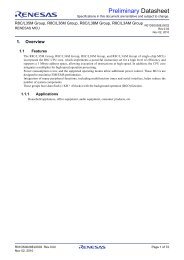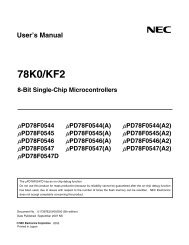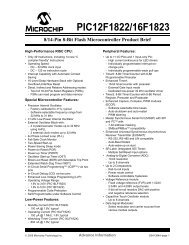xmega a3u - Elfa
xmega a3u - Elfa
xmega a3u - Elfa
You also want an ePaper? Increase the reach of your titles
YUMPU automatically turns print PDFs into web optimized ePapers that Google loves.
XMEGA A3U<br />
28. ADC – 12-bit Analog to Digital Converter<br />
28.1 Features<br />
• Two Analog to Digital Converters (ADCs)<br />
• 12-bit resolution<br />
• Up to two million samples per second<br />
– Two inputs can be sampled simultaneously using ADC and 1x gain stage<br />
– Four inputs can be sampled within 1.5µs<br />
– Down to 2.5µs conversion time with 8-bit resolution<br />
– Down to 3.5µs conversion time with 12-bit resolution<br />
• Differential and single-ended input<br />
– Up to 16 single-ended inputs<br />
– 16x4 differential inputs without gain<br />
– 8x4 differential input with gain<br />
• Built-in differential gain stage<br />
– 1/2x, 1x, 2x, 4x, 8x, 16x, 32x, and 64x gain options<br />
• Single, continuous and scan conversion options<br />
• Four internal inputs<br />
– Internal temperature sensor<br />
– DAC output<br />
–V CC voltage divided by 10<br />
– 1.1V bandgap voltage<br />
• Four conversion channels with individual input control and result registers<br />
– Enable four parallel configurations and results<br />
• Internal and external reference options<br />
• Compare function for accurate monitoring of user defined thresholds<br />
• Optional event triggered conversion for accurate timing<br />
• Optional DMA transfer of conversion results<br />
• Optional interrupt/event on compare result<br />
28.2 Overview<br />
The ADC converts analog signals to digital values. The ADC has 12-bit resolution and is capable<br />
of converting up to two million samples per second (msps). The input selection is flexible, and<br />
both single-ended and differential measurements can be done. For differential measurements,<br />
an optional gain stage is available to increase the dynamic range. In addition, several internal<br />
signal inputs are available. The ADC can provide both signed and unsigned results.<br />
This is a pipelined ADC that consists of several consecutive stages. The pipelined design allows<br />
a high sample rate at a low system clock frequency. It also means that a new input can be sampled<br />
and a new ADC conversion started while other ADC conversions are still ongoing. This<br />
removes dependencies between sample rate and propagation delay.<br />
The ADC has four conversion channels (0-3) with individual input selection, result registers, and<br />
conversion start control. The ADC can then keep and use four parallel configurations and<br />
results, and this will ease use for applications with high data throughput or for multiple modules<br />
using the ADC independently. It is possible to use DMA to move ADC results directly to memory<br />
or peripherals when conversions are done.<br />
8386B–AVR–12/11<br />
50

















